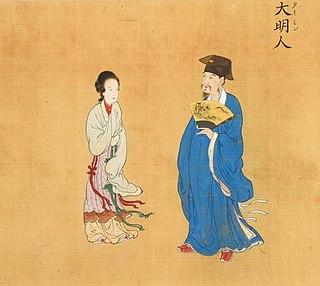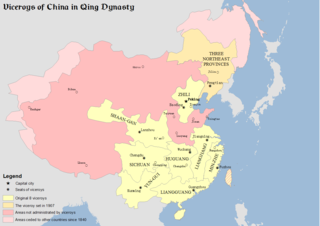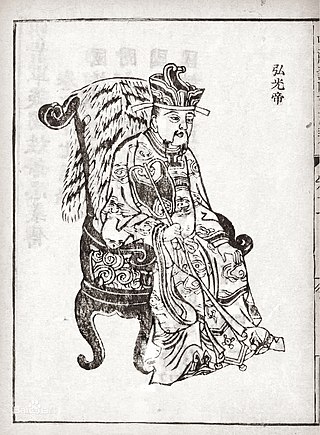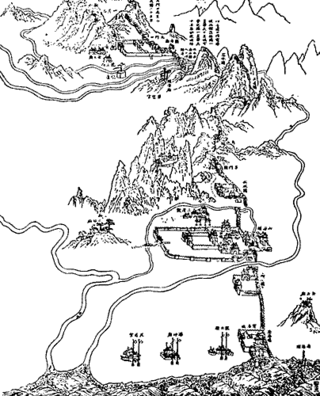This relies largely or entirely on a single source .(July 2018) |
| |||||
| Decades: | |||||
|---|---|---|---|---|---|
| See also: | Other events of 1644 History of China • Timeline • Years | ||||
Events from the year 1644 in China.

This relies largely or entirely on a single source .(July 2018) |
| |||||
| Decades: | |||||
|---|---|---|---|---|---|
| See also: | Other events of 1644 History of China • Timeline • Years | ||||
Events from the year 1644 in China.


Li Zicheng, born Li Hongji, also known by his nickname, the Dashing King, was a Chinese peasant rebel leader who helped overthrow the Ming dynasty in April 1644 and ruled over northern China briefly as the Yongchang Emperor of the short-lived Shun dynasty before his death a year later.

Wu Sangui, courtesy name Changbai (長白) or Changbo (長伯), was a Chinese military leader who played a key role in the fall of the Ming dynasty and the founding of the Qing dynasty. In Chinese folklore, Wu Sangui is regarded as a disreputable Han Chinese traitor for his surrender to the Manchu invaders, suppression of the Southern Ming resistance and execution of the Yongli Emperor. Wu eventually double-crossed both of his masters, the Ming and the Qing dynasties.
The Chongzhen Emperor, personal name Zhu Youjian, courtesy name Deyue (德約), was the 17th and last emperor of the Ming dynasty. He reigned from 1627 to 1644. "Chongzhen", the era name of his reign, means "honorable and auspicious."

Chongzhen was the era name (nianhao) of the Chongzhen Emperor, the last emperor of the Ming dynasty. It was also the final era of the Ming, lasting for 17 years.

Zongdu were the managers supervising provincial governors in Ming and Qing China. One viceroy usually administered several provinces and was in charge of all affairs of military, food, wages, rivers, and provincial governors within their region of jurisdiction. Viceroys was appointed by and directly reported to the Emperor.

The Hongguang Emperor, personal name Zhu Yousong, childhood nickname Fuba (福八), was the first emperor of the Chinese Southern Ming dynasty. He reigned briefly in southern China from 1644 to 1645. His era name, "Hongguang", means "great light".

The Battle of Shanhai Pass, fought on May 27, 1644 at Shanhai Pass at the eastern end of the Great Wall, was a decisive battle leading to the beginning of the Qing dynasty rule in China proper. There, the Qing prince-regent Dorgon allied with former Ming general Wu Sangui to defeat rebel leader Li Zicheng of the Shun dynasty, allowing Dorgon and the Qing army to rapidly conquer Beijing.

The Shun dynasty, officially the Great Shun, also known as Li Shun, was a short-lived Chinese dynasty that existed during the Ming–Qing transition. The dynasty was founded in Xi'an on 8 February 1644, the first day of the lunar year, by Li Zicheng, the leader of a large peasant rebellion, by proclaiming himself "emperor" (皇帝) instead of the title "king" (王) before founding the dynasty.

Hong Chengchou, courtesy name Yanyan and art name Hengjiu, was a Chinese official who served under the Ming and Qing dynasties. He was born in present-day Liangshan Village, Yingdu Town, Fujian Province, China. After obtaining the position of a jinshi in the imperial examination in 1616 during the reign of the Wanli Emperor, he joined the civil service of the Ming Empire and served as an official in Shaanxi. During the reign of the Chongzhen Emperor, he was promoted to Minister of War and Viceroy of Jiliao. In 1642, he surrendered and defected to the Manchu-led Qing Empire after his defeat at the Battle of Songjin. He became one of the Qing Empire's leading Han Chinese scholar-politicians. While he was in office, he encouraged the Manchu rulers to adopt Han Chinese culture and provided advice to the Qing government on how to consolidate its control over the former territories of the fallen Ming Empire. Apart from Dorgon and Fan Wencheng (范文程), Hong Chengchou was regarded as one of the most influential politicians in the early Qing dynasty. However, he was also villainised by the Han Chinese for his defection to the Qing Empire and for his suppression of the Southern Ming dynasty.

The Jiashen Incident, also known as the Battle of Beijing, took place in 1644 in the areas surrounding Beijing, and was fought between forces of the incumbent Ming dynasty and the Shun dynasty founded by peasant rebel leader Li Zicheng. It eventually resulted in the collapse of the Ming dynasty. Remnants of the Ming imperial family, whose regime is known as the Southern Ming dynasty in historiography, would continue to rule parts of southern China until 1662.

The Affaire in the Swing Age, also known as The Dynasty or Love Against Kingship, is a 2003 Chinese television series based on the novel Jiangshan Fengyu Qing by Zhu Sujin, who was also the screenwriter for the series. The series depicts the events in the transition of the Ming dynasty to the Qing dynasty in China, focusing on the lives of historical figures such as Li Zicheng, Wu Sangui, Chen Yuanyuan, the Chongzhen Emperor and Huangtaiji.
Empress Xiaojielie, of the Zhou clan, was a Chinese empress consort of the Ming dynasty, married to the Chongzhen Emperor. She is commonly referred to as Empress Zhou.

The transition from Ming to Qing or the Manchu conquest of China from 1618 to 1683 saw the transition between two major dynasties in Chinese history. It was a decades-long conflict between the emerging Qing dynasty, the incumbent Ming dynasty, and several smaller factions. It ended with the consolidation of Qing rule, and the fall of the Ming and several other factions.
Gong Dingzi (龔鼎孶) (1615–1673) was a Chinese poet and politician. He was a famous author and Classical Chinese poet. He was also a government official serving under the Ming Chongzhen Emperor, the short-lived Dashun regime of peasant-rebel Li Zicheng, and then the Manchu-led Qing dynasty. Along with Wu Weiye and Qian Qianyi, Gong Dingzi was famous as one of the Three Masters of Jiangdong.
Geng Zhongming was a Chinese military general who lived through the transition from the Ming (1368–1644) to the Qing (1644–1912) dynasty, during which he served both sides. His grandson Geng Jingzhong was one of the Three Feudatories who rebelled against Qing rule in the 1670s.

The Later Jin, officially known as Jin or the Great Jin, was a Jurchen-led royal dynasty of China in Manchuria and the precursor to the Qing dynasty. Established in 1616 by the Jianzhou Jurchen chieftain Nurhaci upon his reunification of the Jurchen tribes, its name was derived from the earlier Jin dynasty founded by the Wanyan clan which had ruled northern China in the 12th and 13th centuries.

The late Ming peasant rebellions were a series of peasant revolts during the last decades of the Ming dynasty lasting from 1628–1644. They were primarily caused by natural disasters in Shaanxi, Shanxi, and Henan. At the same time, the She-An Rebellion and Later Jin incursions forced the Ming government to cut funding for the postal service, which resulted in the mass unemployment of men in the provinces hit hard by natural disasters. Unable to cope with three major crises at the same time, the Ming dynasty collapsed in 1644.

The Great Plague in the late Ming dynasty, also known as the North China Plague in the late Ming dynasty, or the Great Plague of Jingshi, was a major plague epidemic between 1633 and 1644, the last phase of the Ming dynasty in China, during the Chongzhen Emperor's reign (1627–1644). The epidemic started in Shanxi in 1633 and reached Beijing in 1641, where the plague caused the deaths of more than 200,000 people in 1643, directly contributing to the collapse of the Ming dynasty in 1644.
Zhu Cilang was a crown prince of the Ming dynasty. He was the eldest son of the Chongzhen Emperor and Lady Zhou, Empress Xiaojielie, and he was made the crown prince in 1630.
Ma Shiying, courtesy names Yaocao and Chongran, was a notorious government official who lived in the late Ming dynasty. He served under the Southern Ming Hongguang regime and was best known for instigating internecine conflict within the court.